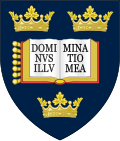This article needs additional citations for verification .(October 2018) |
Parent institution | Information Engineering Research Cluster, Department of Engineering Science, University of Oxford |
|---|---|
| Director | Nick Hawes |
The Oxford Robotics Institute (ORI) is an interdisciplinary division within the University of Oxford. It is dedicated to researching robotics, artificial intelligence, systems engineering, and other related fields. The ORI is a subsidiary of the Department of Engineering Science. [1]
Contents
Information engineering Professor Nick Hawes is the current director of the ORI.

